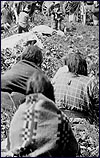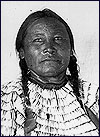|
|
|
| ||
|
| ||||
 Gathering at Standing Rock Agency for meat issue.
Hattie Lawrence, |
| IN THE SUMMER OF 1911, Densmore set up shop on the Standing Rock Sioux Reservation, which straddles the North Dakota-South Dakota border. These were Sitting Bull's people. Many of the elders had fought with the great Hunkpapa chief. Densmore interviewed more than fifty elders about the sacred Sun Dance ceremony, which the U.S. government banned in 1882 to force the assimilation of native people into Christian society. Her most important informant was an 80-year-old Lakota named Red Weasel.
He came very unwillingly, traveling 43 miles by stage and wagon and when he had arrived and had accepted the tobacco which I had provided. He said that he came against his wishes and did not wish to tell me anything. He said the truths of the Sun Dance were very sacred to him and he intended they should die with him.12 Red Weasel and many others eventually relented when Densmore pressed them to let her record the rituals of the Sun Dance for preservation in Washington. The interviews were a series of solemn conferences. The elders spoke in reverent, often fearful tones. All others were kept away. It was - and remains - a common belief among traditional Indians that speaking inappropriately on sacred subjects can result in foul luck and even death. Densmore managed to persuade many of them anyway. On one remarkable afternoon, Densmore and some of her informants drove out into the prairie to locate the site of the last Sun Dance, held 29 years before. Some of the old men pulled on their feathered war bonnets and buckskin jackets. They located the sacred buffalo skull with its faint trace of red ceremonial paint. It was a moving scene, and Densmore couldn't help romanticizing the event a bit when she wrote her book on the Teton Sioux.
Pass the pipe from hand to hand in the old way. Jest [sic] a little. Yonder man tells too fine a story of his part in the Sun Dance-let him show his scars. Yet the memories, how they return!13 Densmore spent three more summers working among the Dakota and Lakota Sioux. She made hundreds of recordings and photographs. She gathered dozens of religious and every-day artifacts. By the end of her stay, Densmore was accepted enough to be adopted by a Lakota elder who had had lost his own daughter. Densmore collected her findings in a monumental volume titled, Teton Sioux Music, and published by the BAE in 1918. The book is still read by scholars and Lakota people. Indian singers at Standing Rock and other reservations use cassette tapes of the Densmore cylinder recordings to reclaim traditional songs.
LISTEN (RealAudio 2.0 14.4 kbps)
Dale Weasel Interview
To Move | ||

